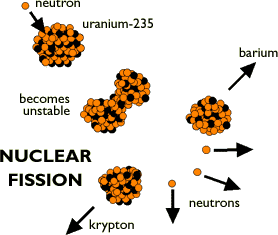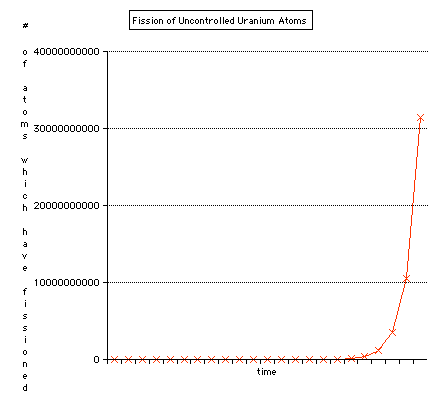

(Used with permission. Original found at: http://www.sciencenet.org.uk/database/Physics/Atomic/p00435c.html)
|
# of atoms which have split
|
 |
|
1
3 9 27 81 243 729 2187 6561 19683 59049 177147 531441 1594323 4782969 14348907 43046721 129140163 387420489 1162261467 3486784401 10460353203 31381059609 |
- There are several different designs for nuclear power plants. The variations are mostly in what material surrounds the nuclear fuel and how the fuel is packaged.
- Most of the nuclear power plants in use today in the US are of the design depicted above. These plants are very old and no new plants have been constructed since the early seventies. This is primarily due to the safety concerns people have had regarding a major catastrophe at one of the plants.
- If for some reason the fission reaction goes out of control, it is possible to have a large release of radioactive material. It is impossible to have a nuclear explosion like that of an atomic bomb, but a major accident at a nuclear power plant would be devastating to the surrounding area. Fortunately, there are MANY safety systems and backups for the backup systems to prevent this. The only major release of radiation occurred in 1986, at the Chernobyl nuclear power plant in Kiev (the former Soviet Union). And this happened only because the people operating the plant disregarded virtually every safety regulation and disconnected the safety systems to run a test. Even the design of the plant is much more dangerous than any power plant in operation here in the US.
- Some people fear that just living near a nuclear power plant can expose them or their children to high amounts of radiation, but this is not true. Living right next to a power plant would add only about 1 mrem (of the 360 mrem present in the normal background radiation) per year of radiation.
- Today there are plant designs that are inherently much safer than those already in operation. However, concern over the dangers of nuclear power have prevented any of these plants from being built.
- Many proponents of nuclear power say that it is "clean" power. What they mean is that the air pollution caused by the burning of coal, oil, or gas, is not created in nuclear power plants.
- While this is true, the main environmental issue with nuclear power plants is the highly radioactive waste they produce. To date, we still have no solution as to how this waste can be safely stored. Currently, all the nuclear waste that is produced is kept in relatively unsecured storage facilities at the power plant. They have no place to put it.
- Several of the isotopes present in the waste have very long half-lives requiring that the waste be stored for 10,000 - 100,000 years before they have decayed to a safer low level.
- The only real option being considered today is underground storage of the waste under Yucca mountain in Nevada. After decades of study, there is still controversy over whether this site is suitable to safely contain the nuclear waste over the time periods necessary.
previous page
chemsite homepage
